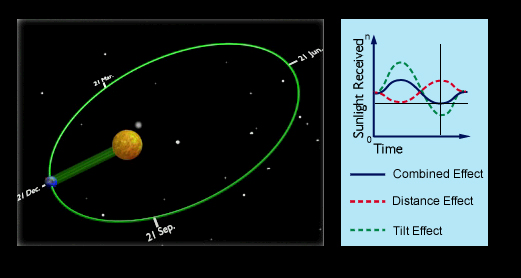Atmosphere Contents
3. Energy Variation
The combined effect of obliquity (tilt) and eccentricity modifies radiation input over a year

Tilt and eccentricity combine together to produce the seasons we know (e.g. summer in the northern hemisphere at the same time as winter in the southern hemisphere and vice versa), but can also have an influence of the intensity of the seasons. In December, the Earth is closest to the sun and the Earth's tilt means winter and summer occur in the northern and southern hemispheres, respectively. In June, when the Earth is furthest way from the sun, the tilt effect results in a switch in the seasons experienced by the hemispheres.
Now, in the southern hemisphere, the tilt and eccentricity effects reinforce each other to produce more intense seasons. In December, the tilt is pointing the southern hemisphere at the sun, while eccentricity produces the minimum Earth-Sun distance. And in June, the Earth-Sun distance is at its maximum and the southern hemisphere is now pointed away form the sun. Therefore, warmer and colder summers and winters, respectively. But in the northern hemisphere, the tilt and eccentricity effects are always counteracting each other, so the seasons are not so intense.
What are the combined effects of tilt and eccentricity?